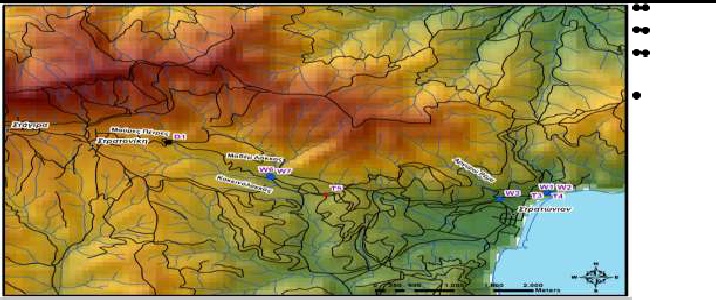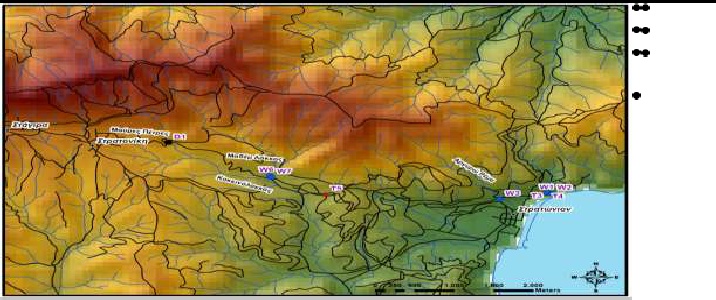- GENERAL
The mining and metallurgical wastes come from the survey or prospecting or mining and processing of solid, liquid and gaseous deposits, which due to their high content of heavy metals and other hazardous substances constitute a potential hazard and may cause irreversible environmental damage. The major accidents that occurred in Europe and the environmental and economic devastation of local communities convinced the European Commission to introduce EU-wide regulations, such as Directive 2006/21/EC and numerous other decisions in order to prevent similar events in the future and to succeed in creating an effective management of mining wastes. The National Law Directive was incorporated by Act no 39624/2209/E103 with JMD (GG 2076v/25-09-2009) and includes the provisions of Directive 2006/21/EC on the management of wastes from extractive industries, given the current status of mining activities in Greece. The impact on air quality is affected by the emissions of particulate matter, gases and heavy metals coupled with solid wastes from the mining activity itself by the composition of deposits in infertile (sterile) materials. Standard practice in Greece is the placement of solid wastes in obsolete arcades when it comes to underground workings, or in obsolete outdoor farms or grades within the mining or quarry area. The stages tips should have been properly compressed, a small gradient height and slope and a large deck width should be adopted, slightly inclined gradient slope, with coverage of the floors of the levels with soil and finally planting material and floor slopes should be placed so as to prevent landslides and contact of the mineral tips with atmospheric oxygen which causes acid runoff (effluents of mining holdings). Acid runoff can also be created by the presence of an aquifer within the deposits. The Special Environmental Inspectorate Agency, under the aegis of the Special Secretariat, within its competence and in accordance with Article 17 of that Directive which requires the authority to inspect any waste facility even before the commencement of deposition operations, carried out inspections in mining and metallurgical enterprises in Chalkidiki, Euboea, Boeotia, e.t.c.
- CHALKIDIKI
Since Aristotle’s era, gold mining was carried out in Chalkidiki. This gold funded the kingdom of Macedonia and the campaigns of Alexander the Great. During the Ottoman era the twelve villages were also known as the villages of copper because apart from gold the underground was rich in copper, manganese, zinc and silver. A team of Environmental Inspectors along with scientists from the Institute of Geology and Mineral Exploration and with the presence of the Special Secretary of Energy & Environmental Inspection visited a similar contemporary activity in Chalkidiki. The autopsy which was held in May 2010 (before the issuance of the environmental conditions) was designed to identify the environmental problems created by the old and new mining activity and provide suggestions for better and sound environmental management of wastes. The inspection focused on the management of solid and liquid wastes generated from mining and enrichment of mixed sulphide mineralization of auriferous-silver and auriferous-copper ore purpura (under construction) followed by the metallurgical processing of the condensate. Wastes generated from these activities are labeled by the European Waste Catalogue as potentially dangerous. Examples of problems that can arise from such facilities are:
- The sitting and management of mining waste rocks (new and old)
- Sitting and management of tailings (tailings ponds)
- Rehabilitation of disposal sites of historical waste metallurgical activity and of the enrichment plant,
- Port construction (extension of the existing ones and creation of new ones) for the loading of mining and processing of products which pose risks to the marine environment.
- The investment will have a lifespan of more than 30 years, and its implementation will require investments of around 1 billion Euros.
The actions made on the day of the autopsy included the following activities:
- The mixed sulphide ore mine in the Black Stone regions (active) and Cast Iron Pit (off)
- The enrichment plant at Stratoni
- The enrichment tailings dumps, tailings and industrial waste areas and Karakoli Chevalier and other venues.
According to the committee’s report on compliance with environmental conditions (inspect) of 121 environmental conditions issued in 1999 and 2005, 99 of them were met with no differences, 11 partially met and 11 not met at all. Deviations from compliance with the conditions mainly involved solid waste management and rehabilitation of disposal sites. During the autopsy samples of waters were shipped for analysis at the IGME. The results of the water samples indicated that the mine water quality discharged to water bodies (sea, Kokkinolakkas, Mavrolakkas) met environmental conditions set by the Prefecture of Chalkidiki.
Map 1. Map showing sampling locations in Stratoni mines and Black Stones, Mademia
A sample of surface water was also taken from stream “Argyro” that passes through the eastern outskirts of Stratoni, upstream of mining activities, was found to contain relatively high values of heavy metals (Zn, Mn, Cd, Ni) and SO4, a result attributed to the natural mineralizations of the geological background. From the area of the mine Olympiad, two samples were taken, one from surface water of Mavrolakkas near the deposition location of the enrichment plant and one from the Olympias mine waters in the point that are rejected in Mavrolakkas. The waters of the mine Olympiad generally contained low concentrations of heavy metals, toxic elements and sulfate radicals and generally all concentrations were below the permissible limits for discharge of liquid waste in the natural recipients of Chalkidiki (Chalkidiki NE 96400/85, Official Gazette573V). In Mavrolakkas’ stream, in the position upstream of the point of discharge of mine water, the water conductivity is low (331 μS / cm) as well as in the waters of the mine in place Olympiad in Mavrolakkas rejection place (600 μS / cm). Surface waters of Mavrolakkas, upstream of the mining operations, contain relatively high rates in arsenic (30 μgr / l), but no more than the permissible limit quality of the stream which is 50 μg / l. The values of dissolved oxygen (DO) which range between 6,2-9,2 mg / l are considered normal.
Acidity (pH):
The raw waters that are being processed in the unit of Stratoni are acidic (pH= 2.6) and the ones that are treated in Mademia Pit unit are slightly acidic (pH = 6.21). In Olympiad mine, the waters are alkaline (pH = 8.24). The water from the Silver Stream and Mavrolakkass is also alkaline (pH = 7.47 and 8.66 respectively).
Conductivity:
The conductivity of the water processing unit of Stratoni before neutralization is 4010 μS / cm and 3330 μS / cm after neutralization. Correspondingly, the conductivity of water in Mademia Pit unit is 1550 μS / cm before neutralization and 1310 μS / cm after neutralization. Note that the conductivity limits of drinkable water is 2500 μS / cm and pH = 9,5. In the stream Argyro, conductivity of surface water is 2198 μS / cm, indicating that water, even upstream of the mining installation, is affected by the presence of hot spots (oxidized metalliferous areas of scattered pyrite mineralization that is indigenous to the natural background and metalliferous deposits of steriles). In Mavrolakkas stream, upstream of the point of discharge of mine waters, the conductivity is low (331 μS / cm) and water in the mine Olympiad is also low (600 μS / cm). Values of dissolved oxygen (DO) are ranging from 6.2-9.2 mg / l and are considered normal. By treating the waters of the mines Mademia Pit and Black Stones which have high concentration levels of heavy metals (Al, Fe, Pb, Zn, Mn, Cd, Ni, Co, As, Ca, Mg, Ba, sulphates roots (SO4)), can become cleaner, thereby lowering their concentration values and meet the required standards for discharging them into water bodies. Note that the stream Kipouristas passes through areas with slag deposits which are remains of old mining activity upstream of the mine Olympiad. According to previous water samples analysis from stream Kipouristas, relatively elevated concentrations in arsenic were observed (30-80 μgr / l), and its waters contribute to the surface waters in Mavrolakkas. During the process of recovering the polymetallic porphyry-gold (flash smelting) through pyrometallurgical methods, it is expected that significant quantities of gaseous and particulate compounds will be produced.
Map 2. Map of sampling locations also in Stratoni, mines and Black Stones Mademia Pit
The Special Inspection Secretariat of Environment and Energy submitted proposals to minimize the expected environmental impacts which were related with the use and application of the best available techniques, the remediation of the wider environment and the undoing of the effects of the longitudinal mode of the mines, creating an effective and reliable mechanism for monitoring and controlling the operation of the activity, protection, restoration and management of surface and groundwater in rational and sustainable manner, according to the principles of PD 51/07 (Directive 2000/60/EC on the water), implementing Directive 2004/35/EC and PD 148/09 on environmental liability, waste management of all mining activity in accordance with the principles of the legislation, establishing strict safety standards for new waste dumps and thorough investigation of the risk of all materials, excluding use of cyanide technology in metallurgy gold, using pyrometallurgical method (according to the company’s proposal), project design for the environment even worse extreme scenarios, given the worsening of extreme weather events and climate change, but the intense seismicity of the region, searching for new sites tailings deposition because the existing landfills and waste ponds Karakoli Chevalier was not sufficient for the extra volume of waste disposal, e.t.c.
By S. ELEFTHERIADOU*: Special Environmental Inspectors Agency, Hellenic Ministry for the Environment and Climate Change, South Greece Division, Athens, Greece
Source: www.scribd.com, published by tzeferisp
* The passage of Chalkidiki was conducted with the support of the Special Secretary of Environmental and Energy Survey Mr M. Karavassili
REFERENCES: Panias Dimitrios, Associate Professor, Metallurgy of Alluminium 2.
http://www.sme.gr/proionta-sme-orykta/50-xrysos 3.
http://www.oryktosploutos.net/2011/05/blog-post_04.html 4.
http://www.hellenicparliament.gr/UserFiles/67715b2c-ec81-4f0c-ad6a-476a34d732bd/7246462.pdf


